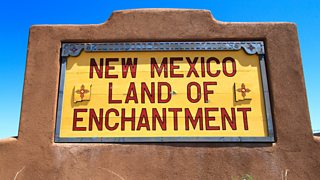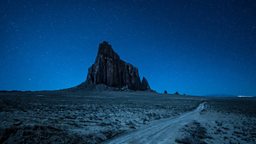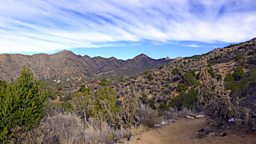Why is this desert landscape known as the "Land of Enchantment"?

To many people, New Mexico’s dramatic deserts are best known as the backdrop for TV series Breaking Bad. But this “Land of Enchantment” – as New Mexico’s licence plates have it – is also home to a bewildering number of artists, writers and musicians.
They make for an eclectic list: DH Lawrence, Georgia O’Keeffe, Agnes Martin, Pauline Oliveros, Meredith Monk, Henry Shukman, Harmony Hammond... the list goes on. In Radio 3's Sunday Feature: Savage Pilgrims, Sara Mohr-Pietsch visits New Mexico's historic artistic communities to find out what it is about the Land of Enchantment that draws them together.
1. The light
Ever since the railroad arrived in New Mexico in the late 19th century, a steady trickle of outsiders have come, drawn to (and inspired by) the area’s humbling vastness. The writer DH Lawrence arrived in 1920, bound on a "savage pilgrimage" – a period of wanderlust and introspection that began after the horror of the war years. By 1924, he had bought a ranch in Taos, a town in the north-central region of the state.
The following year saw Lawrence fall seriously ill with malaria and tuberculosis. He was forced to return to Europe where in 1928 he wrote the following in an essay entitled “New Mexico”. He, like many other visitors to New Mexico, was dazzled by the clarity of its light.
"The moment I saw the brilliant, proud morning shine up over the deserts of Santa Fe, something stood still in my soul, and I started to attend... In the magnificent fierce morning of New Mexico one sprang awake, a new part of the soul woke up suddenly, and the old world gave way to a new.” – DH Lawrence, writer

2. The mix of ancient and modern cultures
New Mexico's landscape is steeped in history, having witnessed thousands of years of native culture, 200 years as a Spanish colony and half a century of Mexican rule before becoming a US state in 1912.
Today, New Mexicans describe their state as “tri-cultural”. Firstly there is Native American culture (including the Pueblo peoples and members of the Navajo and Apache tribes). Then there’s Hispanic culture, which encompasses everyone from indigenous Mexicans (Chicano) to direct descendants of the earliest Conquistadors. Finally, there are the white North American colonists, who are known locally as Anglos.
The sculptor Jom Joyce has lived in New Mexico since his teenage years. In 1970, he moved to the small Hispanic community of El Rito, where he became an apprentice to the local blacksmith.
“There’s hardly a day goes by that I don’t thank the people that I encountered as a youngster that felt like taking the time to be able to teach me make adobe, how to create electricity from wind generation, how to grow food, both in a greenhouse and out in the field, to be able to take clay from the arroyo and make a pot that not only looks good but be used to serve or cook a meal.
"When we build by hand in New Mexico, we’re cloaking ourselves in large measure in the very earth we spend our lives in.” – Tom Joyce, sculptor

3. The vastness of the desert sky
Raven Chacon is a composer and sound artist based in Albuquerque whose work ranges from string quartets to noise art and sound installations. He grew up in Navajo Nation, New Mexico, and as a teenager would go out into the desert to experiment with new music.
Today, his practice as a composer has the same kind of reciprocal relationship with the landscape through sound as others have through the the earth.
“I’ve been making music since I was about eight years old. Some of the first shows I would play, because I didn’t know if anybody would like the music, we would go out to the West mesa, here in the desert, 10 miles out of town, and play music for ourselves.
"It's very beautiful out there, and you can be as loud as you want – and that probably informed a lot of the music I ended up making. There's nothing for the noise to reflect off of, so it would just get lost out there in the desert." – Raven Chacon, composer and sound artist

4. The silence of the hills
The composer Meredith Monk’s love affair with New Mexico began in 1979, after a summer spent in the hills of Placitas, between Albuquerque and Santa Fe. It was here that she composed her famous Songs From the Hill, venturing out into the hills every day armed only with her voice and a tape recorder.
She now owns a remote studio in the far north of the state, where she composed many of her major vocal works.
"I was very inspired by the landscape. It's so timeless, you feel like a dinosaur could be walking across the mountains. It has an extraordinary spatial and magical quality.
"You can imagine, being a New Yorker, that going to New Mexico is an antidote to the aural poison that I'm dealing with every day. Just to be able to hear the way that nature orchestrates these beautiful entrances and exits and these different layers of sounds is something that means so much to me. When I work on music there, the silence is built into that." – Meredith Monk, multidisciplinary composer and artist

5. The harshness of the landscape
The New Mexico landscape may invite meditation for some – but, as anyone who practises it regularly will tell you, meditation can bring you face to face with your demons. So, too, can the harsh New Mexico landscape.
The soil and dust of New Mexico are highly alkaline – just a few days spent there will make your hands start to feel like sandpaper. This is a land that can quite literally strip you bare if you let it. The artist Richard Tuttle knows this only too well: he and his wife, the poet Mei-Mei Beursenbruegge, live atop a steep hill on a remote high mesa just outside Abiquiu.
“One of the things people say is that it’s so tough. There are only a few things that survive here, and they’re some of the toughest things in the world. [New Mexico] does that to people as well. For some artists, it’s a landscape that really helps them do their work.” – Richard Tuttle, artist

Sara Mohr-Pietsch explores the artistic communities of New Mexico in the Sunday Feature: Savage Pilgrims. Listen online via the Radio 3 website now.
-
![]()
Savage Pilgrims
Discover the red land, clear light and the humbling, savage vastness of this Land of Enchantment.
-
![]()
"I grew up in an apocalyptic cult"
Flor Edwards grew up believing that the world would end when she was 12. This is her story.
-
![]()
A new side to David Attenborough
Sir David introduces the field recordings he made of people, not animals, on his travels around the globe.
-
![]()
Radio 3's Sunday Feature
In-depth documentaries on music, history, science, philosophy, film, visual arts and literature.




